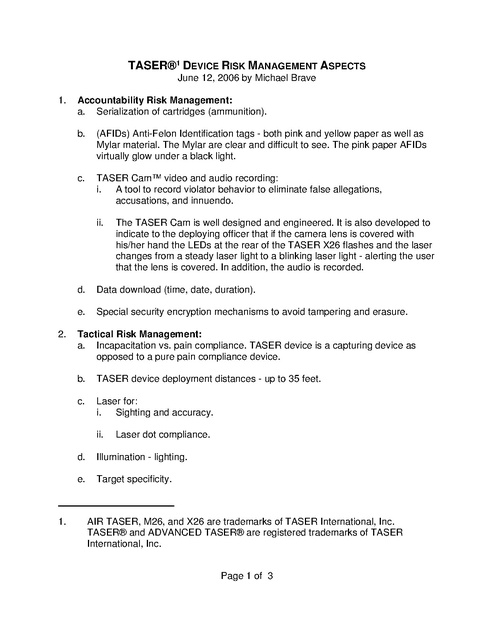Taser Device Risk Management Apects 2006
Download original document:

Document text

Document text
This text is machine-read, and may contain errors. Check the original document to verify accuracy.
TASER®1 DEVICE RISK MANAGEMENT ASPECTS June 12, 2006 by Michael Brave 1. Accountability Risk Management: a. Serialization of cartridges (ammunition). b. (AFIDs) Anti-Felon Identification tags - both pink and yellow paper as well as Mylar material. The Mylar are clear and difficult to see. The pink paper AFIDs virtually glow under a black light. c. TASER Cam™ video and audio recording: i. A tool to record violator behavior to eliminate false allegations, accusations, and innuendo. ii. 2. d. Data download (time, date, duration). e. Special security encryption mechanisms to avoid tampering and erasure. Tactical Risk Management: a. Incapacitation vs. pain compliance. TASER device is a capturing device as opposed to a pure pain compliance device. b. TASER device deployment distances - up to 35 feet. c. Laser for: i. Sighting and accuracy. ii. 1. The TASER Cam is well designed and engineered. It is also developed to indicate to the deploying officer that if the camera lens is covered with his/her hand the LEDs at the rear of the TASER X26 flashes and the laser changes from a steady laser light to a blinking laser light - alerting the user that the lens is covered. In addition, the audio is recorded. Laser dot compliance. d. Illumination - lighting. e. Target specificity. AIR TASER, M26, and X26 are trademarks of TASER International, Inc. TASER® and ADVANCED TASER® are registered trademarks of TASER International, Inc. Page 1 of 3 f. 3. Muscle Contractions Risk Management: a. Estimated that the TASER device is tuned to approximately 50% of volitional muscle contractions capability (compared to contractions that the person him/herself is capable of). b. 4. Insignificant environmental exposure. Pulse rate tuned to avoid unnecessary muscle tetany. Electrical Risk Management: a. TASER device tuned to affect the peripheral nervous system (sensory nerves and motor nerves). b. Electricity does not collect within the body. c. The depth of current penetration increases with barb placement but is still very small. d. Waveform shape tuned to capture motor neurons but not cardiac muscle. e. TASER pulse discharge less peak current than strong static discharges. [International Standard IEC - 61000-4-2. [30,000 V, 1000 ohms, 30 A peak].] f. TASER device cannot malfunction to a greater electrical discharge. g. TASER current density is down approximately 95% 10 mm from the probes when inserted in tissue (resulting in a large medical safety margin). h. 760 mV or 0.76 V - TASER X26 average volts (V) (one second baseline): i. Start with the main phase charge (85 uC [M26] and 100 uC [X26]). ii. Inter barb resistance is measured at 400 ohms (S). iii. By Ohm's law the voltage = current * resistance. iv. Hence X26 average voltage = 760 mV = 400 * 1.9 mA. v. i. Also the average volts (one second baseline) for the ADVANCED TASER M26 is 1.3 V. TASER device only discharges for a very short duration (the TASER device is only “on” for a very small portion of each second of discharge): i. TASER X26 - each pulse is 100 microseconds (µs). Thus, with 19 pulses per second (pps) the TASER X26 is discharging electrical output for 19/10,000ths of a second, or 0.0019 seconds. Page 2 of 3 ii. j. 5. 6. 7. ADVANCED TASER M26 - discharges for 40 microseconds per pulse * 20 pps = 0.0008 seconds. Cardiac safety margins - Risk of the induction of ventricular fibrillation (VF) from the TASER X26 and ADVANCED TASER M26 with the two scenarios known for cardiac risk: i. For the risk of delivering a pulse into the vulnerable period of the cardiac cycle the charge required is about 100–130 times that which the TASER X26 delivers. The ADVANCED TASER M26 safety margin was calculated at an even higher range of 118-153:1. ii. The risk for the delivery of “continuous” current - a safety margin of 74:1 by two different methodologies for the TASER X26 and ADVANCED TASER M26. iii. It appears that the ADVANCED TASER M26 output is incapable of inducing VF under normal circumstances in adult human beings. TASER Device Training Risk Management: a. TASER Training Program b. TASER Instructor Development Program c. TASER Armorer’s Program d. TASER Chiefs’ Program TASER Device Research - no other force tool or technique as well researched as TASER devices. a. Medical research b. Electrical research c. Field-use research d. Volunteer exposure research Domino Risk Management of Injuries: a. Officer injuries b. Suspect injuries c. Third-party injuries Page 3 of 3

